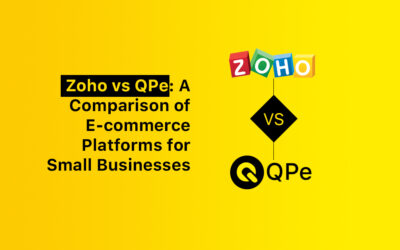Ecommerce has changed the way companies sell, and picking the right tool is important for long-term success. Shopify has become known as a world leader in e-commerce, while QPe has become known as a homegrown option for small businesses. By comparing the Shopify vs QPe features, business owners can find the tool that best fits their needs and budgets.
This blog goes into great depth about both platforms, including their features, pros and cons, and who they are meant for. You will know whether Shopify or QPe is better for your business by the end.
A Look at Shopify’s Features
Shopify is one of the most popular e-commerce platforms in the world. Millions of stores in all kinds of businesses use it. It has many tools that help companies start, run, and expand their online presence.
Key Features of Shopify
- Themes and Templates: Both free and paid professionally designed themes let users make stores that look good.
- App Marketplace: This has thousands of apps for things like shipping, marketing, SEO, and automation.
- Inventory management tools help keep track of products, handle stock, and make sure orders are filled.
- Payments: Shopify Payments and connecting to a number of third-party payment platforms.
- Multichannel Selling: Being able to sell on Amazon, social media sites, and other online stores.
- Records and analytics: On higher-level plans, you can get sales records, customer insights, and more advanced analytics.
- Scalability: It works for small businesses, medium-sized businesses, and big corporations.
The pros and cons of Shopify
By looking at the Shopify pros and cons, its strengths and flaws become more apparent.
Pros:
- Easy for beginners to use
- Able to grow with businesses that want to sell to people around the world
- Safe storage that works quickly
- A lot of customization options through apps
Cons:
- Small businesses may have to pay more than they should.
- Paid styles, add-ons, and other tools on Shopify add up to extra costs.
- Businesses must pay Shopify transaction fees if they don’t use Shopify Payments.
- For advanced modification, you might need to know how to code.
Overview of QPe’s Features
QPe was made to fit the needs of small and medium-sized businesses in India. It has powerful features without being too complicated.
QPe Features
- Mobile-First Design: Made to work best with smartphones, which are the most common type of phone in India.
- Clear pricing: Plans are cheap and simple to understand, and there are no extra fees.
- No Transaction Fees: Businesses don’t have to worry about extra fees taking money away from what they make.
- Integration of local payments: UPI, wallets, and Indian payment systems work without any problems.
- Marketing and Analytics: Plans come with built-in tools for tracking data, advertising, and SEO.
- Easy to Use: The dashboard is simple and intuitive, making setup and control easier for people who aren’t tech-savvy.
- Customization options: free themes and simple customization to match your brand.
QPe makes sure that entrepreneurs can quickly go online without having to deal with high prices or technical problems by focusing on their needs.
Pros and Cons of Each Platform
There are pros and cons to every e-commerce site. Having a clear picture of their pros and cons helps you make a choice.
Shopify Pros:
- Well-known and trusted around the world
- Large app environment for all kinds of needs
- Professional templates with up-to-date styles
- Good for businesses that are growing quickly
Shopify Cons:
- Shopify apps and add-ons can add extra costs
- Shopify charges transaction fees if you don’t use Shopify Payments
- Some useful tools are locked behind pricey levels
- It might be too much for small businesses
Pros of QPe:
- Prices that are clear and don’t have any extra fees
- Made for Indian companies with local features
- Designed with mobile users in mind to make the experience better
- Comes with marketing, SEO, and stats without any extra apps
Cons of QPe:
- It’s still hard to expand internationally
- It doesn’t have as many third-party links as Shopify
- It’s better for small businesses and startups than for big global companies
Shopify vs QPe Features: Head-to-Head
A direct Shopify vs QPe features comparison highlights where each platform excels.
| Feature | Shopify | QPe |
| Pricing | $39 to $399 per month plus add-ons | Affordable, transparent local pricing |
| Transaction Fees | 0.5% to 2% unless using Shopify Payments | None |
| Templates and Themes | Free and paid (often $100+) | Free templates included |
| App Marketplace | Thousands of apps, many with extra cost | Most features built-in, reducing costs |
| Payment Gateways | Global support but limited Indian options | Designed for UPI and Indian gateways |
| Analytics and Reports | Available on mid to high-tier plans | Included in all plans |
| SEO Tools | Available via apps and higher plans | Built-in SEO optimization |
| Marketing Tools | Paid apps for advanced marketing | Free marketing and discount tools |
| International Selling | Strong global capabilities | Primarily focused on Indian market |
| Ease of Use | Beginner-friendly but complex at scale | Simple and intuitive |
| Customer Support | 24/7 global support | Localized India-first support |
| Scalability | Very high, supports large enterprises | High, built for SMB growth |
Who Should Use QPe and Who Should Use Shopify?
Knowing that both platforms are used by different types of people helps business owners make the right choice.
Shopify is great for:
- Companies that want to sell to people in other countries, like the US or Europe
- Businesses that need advanced integrations and scalability
- Brands that want to try out complicated third-party ecosystems; Companies that have more money to spend on apps and add-ons
QPe is great for:
- Indian startups and small companies
- Grocery stores, shops, and other small stores that are going online o Business owners who want things to be easy and cheap
- Owners who want most of the tools to be included in their plan without having to pay extra
For instance, a small fashion business that wants to ship all over the world might find Shopify’s ability to grow better. But QPe is probably better for an Indian grocery shop that wants to accept UPI payments and run deals without spending a lot of money.
In conclusion
Which one you choose between Shopify and QPe relies on the goals of your business. When it comes to Shopify vs QPe features, Shopify beats QPe because it can be used all over the world, it can be scaled up, and it has a large community of apps. But there are Shopify hidden costs and Shopify transaction fees that can make the total cost of the investment much higher.
QPe shines as a cost-effective option with built-in tools. As a result, it makes you less reliant on third-party apps and keeps costs low, making it one of the strongest contenders in a Shopify alternatives comparison.
QPe is one of the best ecommerce platforms for small businesses that you should really think about if you are the owner of a small or medium-sized business. Visit https://goqpe.com/ to find out more and get the latest ecommerce news.



